
lafore_robert_objectoriented_programming_in_c
.pdf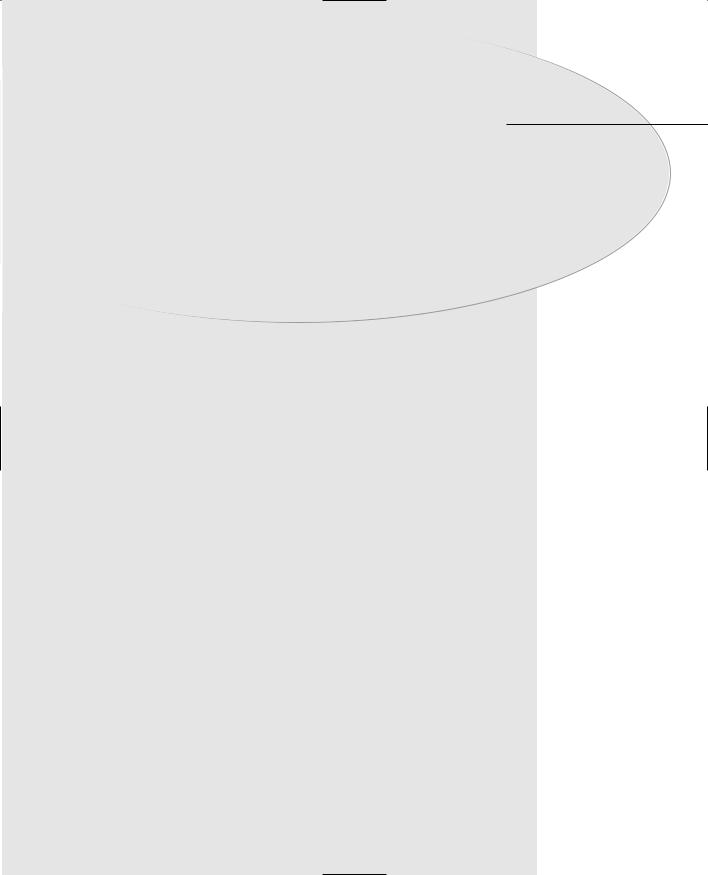
Objects and Classes
IN THIS CHAPTER
• |
A Simple Class |
216 |
|
|
|
• |
C++ Objects as Physical Objects |
223 |
|||
• |
C++ Objects as Data Types 226 |
|
|||
• |
Constructors |
227 |
|
|
|
• |
Objects as Function Arguments |
233 |
|||
• |
The Default Copy Constructor |
238 |
|||
• |
Returning Objects from Functions 240 |
||||
• A Card-Game Example |
243 |
|
|||
• |
Structures and Classes |
247 |
|
||
• |
Classes, Objects, and Memory |
247 |
|||
• |
Static Class Data |
249 |
|
|
|
• |
const and Classes |
252 |
|
|
|
• What Does It All Mean? |
256 |
|
|||
CHAPT E R
6

Chapter 6
216
And now, the topics you’ve all been waiting for: objects and classes. The preliminaries are out of the way. We’ve learned about structures, which provide a way to group data elements. We’ve examined functions, which organize program actions into named entities. In this chapter we’ll put these ideas together to create classes. We’ll introduce several classes, starting with simple ones and working toward more complicated examples. We’ll focus first on the details of classes and objects. At the end of the chapter we’ll take a wider view, discussing what is to be gained by using the OOP approach.
As you read this chapter you may want to refer back to the concepts introduced in Chapter 1, “The Big Picture.”
A Simple Class
Our first program contains a class and two objects of that class. Although it’s simple, the program demonstrates the syntax and general features of classes in C++. Here’s the listing for the
SMALLOBJ program:
//smallobj.cpp
//demonstrates a small, simple object #include <iostream>
using namespace std;
////////////////////////////////////////////////////////////////
class smallobj |
//define a class |
|
{ |
|
|
private: |
|
|
int somedata; |
//class data |
|
public: |
|
|
void |
setdata(int d) |
//member function to set data |
{ |
somedata = d; } |
|
void |
showdata() |
//member function to display data |
{ cout << “Data is “ << somedata << endl; }
};
////////////////////////////////////////////////////////////////
int main()
{ |
|
smallobj s1, s2; |
//define two objects of class smallobj |
s1.setdata(1066); |
//call member function to set data |
s2.setdata(1776); |
|
s1.showdata(); |
//call member function to display data |
s2.showdata(); |
|
return 0; |
|
} |
|
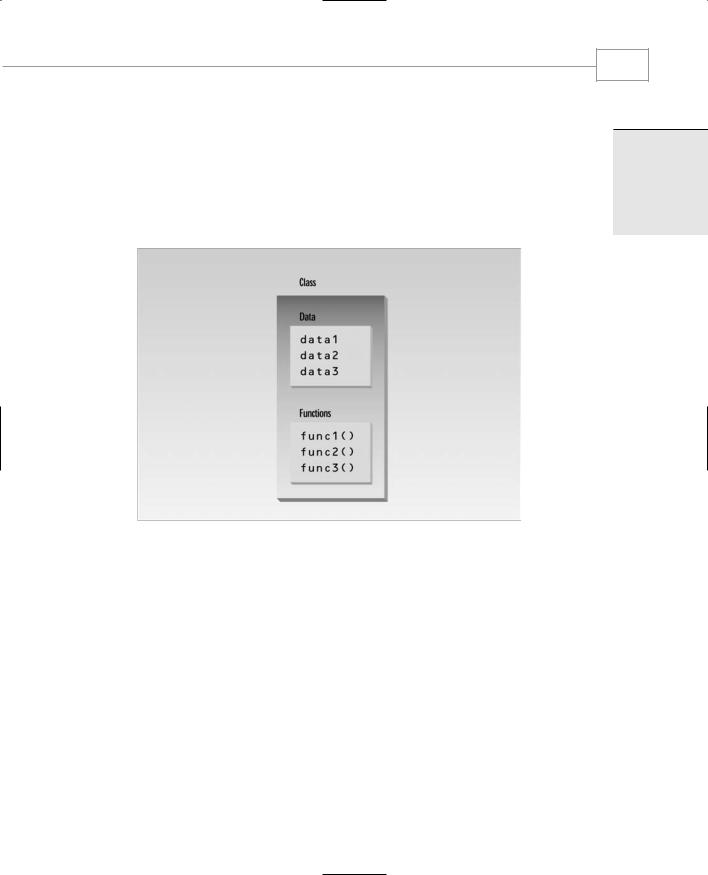
Objects and Classes
The class smallobj defined in this program contains one data item and two member functions. The two member functions provide the only access to the data item from outside the class. The first member function sets the data item to a value, and the second displays the value. (This may sound like Greek, but we’ll see what these terms mean as we go along.)
Placing data and functions together into a single entity is a central idea in object-oriented programming. This is shown in Figure 6.1.
FIGURE 6.1
Classes contain data and functions.
Classes and Objects
Recall from Chapter 1 that an object has the same relationship to a class that a variable has to a data type. An object is said to be an instance of a class, in the same way my 1954 Chevrolet is an instance of a vehicle. In SMALLOBJ, the class—whose name is smallobj—is defined in the first part of the program. Later, in main(), we define two objects—s1 and s2—that are instances of that class.
Each of the two objects is given a value, and each displays its value. Here’s the output of the program:
Data is 1066 ← object s1 displayed this
Data is 1776 ← object s2 displayed this
217
6
C OBJECTS
ANDLASSES

Chapter 6
218
We’ll begin by looking in detail at the first part of the program—the definition of the class smallobj. Later we’ll focus on what main() does with objects of this class.
Defining the Class
Here’s the definition (sometimes called a specifier) for the class smallobj, copied from the
SMALLOBJ listing:
class smallobj |
//define a class |
|
{ |
|
|
private: |
|
|
int somedata; |
//class data |
|
public: |
|
|
void |
setdata(int d) |
//member function to set data |
{ |
somedata = d; } |
|
void |
showdata() |
//member function to display data |
{ cout << “\nData is “ << somedata; }
};
The definition starts with the keyword class, followed by the class name—smallobj in this example. Like a structure, the body of the class is delimited by braces and terminated by a semicolon. (Don’t forget the semicolon. Remember, data constructs such as structures and classes end with a semicolon, while control constructs such as functions and loops do not.)
private and public
The body of the class contains two unfamiliar keywords: private and public. What is their purpose?
A key feature of object-oriented programming is data hiding. This term does not refer to the activities of particularly paranoid programmers; rather it means that data is concealed within a class so that it cannot be accessed mistakenly by functions outside the class. The primary mechanism for hiding data is to put it in a class and make it private. Private data or functions can only be accessed from within the class. Public data or functions, on the other hand, are accessible from outside the class. This is shown in Figure 6.2.
Hidden from Whom?
Don’t confuse data hiding with the security techniques used to protect computer databases. To provide a security measure you might, for example, require a user to supply a password before granting access to a database. The password is meant to keep unauthorized or malevolent users from altering (or often even reading) the data.
Data hiding, on the other hand, means hiding data from parts of the program that don’t need to access it. More specifically, one class’s data is hidden from other classes. Data hiding is designed to protect well-intentioned programmers from honest mistakes. Programmers who really want to can figure out a way to access private data, but they will find it hard to do so by accident.
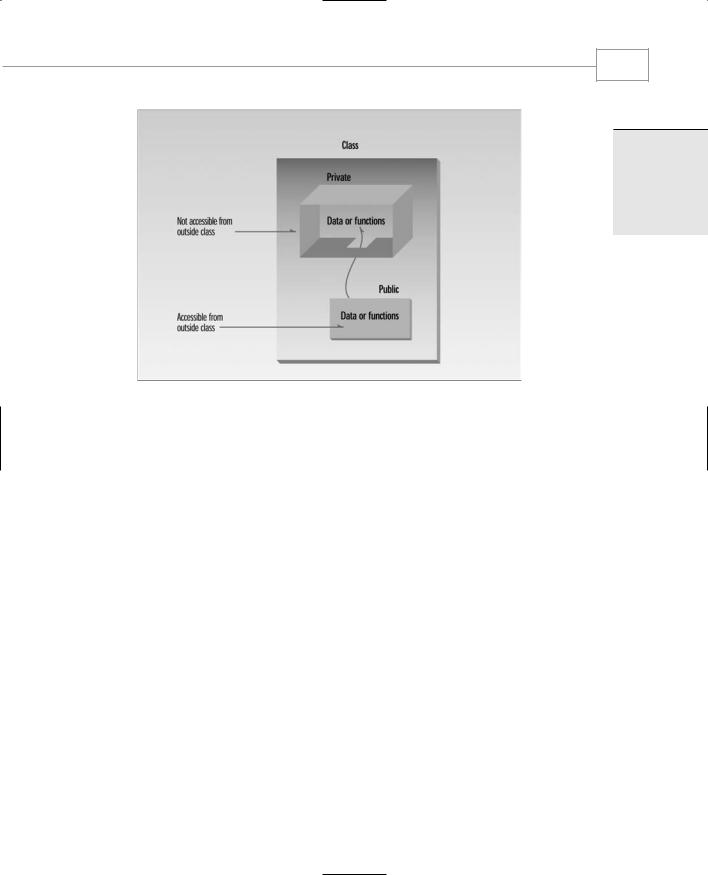
Objects and Classes
219
6
CLASSES
OBJECTS
AND
FIGURE 6.2
Private and public.
Class Data
The smallobj class contains one data item: somedata, which is of type int. The data items within a class are called data members (or sometimes member data). There can be any number of data members in a class, just as there can be any number of data items in a structure. The data member somedata follows the keyword private, so it can be accessed from within the class, but not from outside.
Member Functions
Member functions are functions that are included within a class. (In some object-oriented languages, such as Smalltalk, member functions are called methods; some writers use this term in C++ as well.) There are two member functions in smallobj: setdata() and showdata(). The function bodies of these functions have been written on the same line as the braces that delimit them. You could also use the more traditional format for these function definitions:
void setdata(int d)
{
somedata = d;
}
and
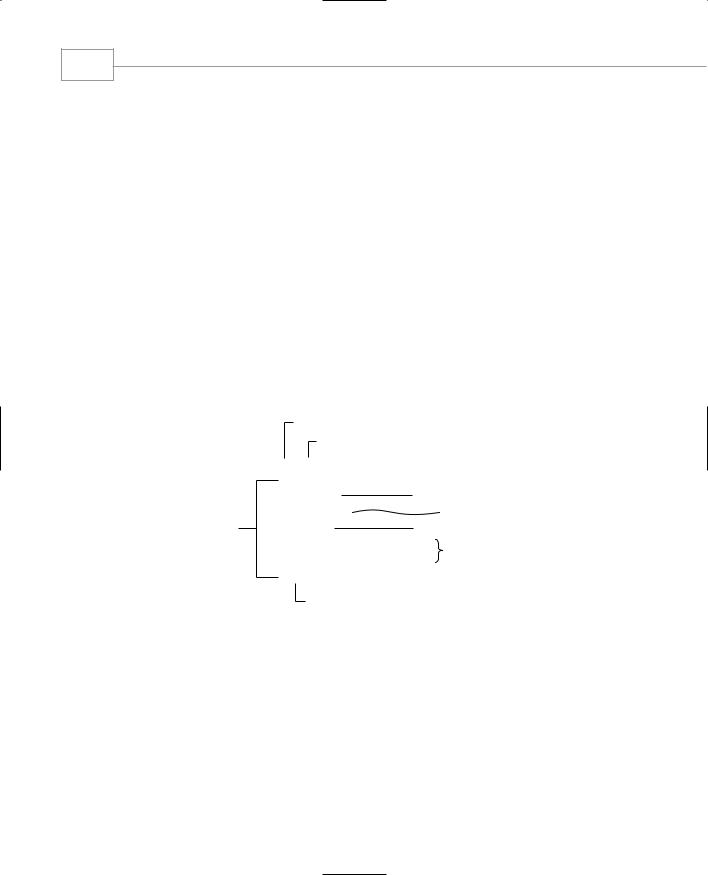
Chapter 6
220
void showdata()
{
cout << “\nData is “ << somedata;
}
However, when member functions are small, it is common to compress their definitions this way to save space.
Because setdata() and showdata() follow the keyword public, they can be accessed from outside the class. We’ll see how this is done in a moment. Figure 6.3 shows the syntax of a class definition.
Functions Are Public, Data Is Private
Usually the data within a class is private and the functions are public. This is a result of the way classes are used. The data is hidden so it will be safe from accidental manipulation, while the functions that operate on the data are public so they can be accessed from outside the class. However, there is no rule that says data must be private and functions public; in some circumstances you may find you’ll need to use private functions and public data.
Braces
FIGURE 6.3
Syntax of a class definition.
Keyword |
|
|
Name of class |
|
|
class foo |
|
|
{ |
|
|
private: |
Keyword private and colon |
|
int data; |
Private functions and data |
|
public: |
Keyword public and colon |
|
void memfunc (int d) |
Public functions and data |
|
{ data = d; } |
||
|
||
}; |
|
|
Semicolon |
|
Member Functions Within Class Definition
The member functions in the smallobj class perform operations that are quite common in classes: setting and retrieving the data stored in the class. The setdata() function accepts a value as a parameter and sets the somedata variable to this value. The showdata() function displays the value stored in somedata.

Objects and Classes
Note that the member functions setdata() and showdata() are definitions in that the actual code for the function is contained within the class definition. (The functions are not definitions in the sense that memory is set aside for the function code; this doesn’t happen until an object of the class is created.) Member functions defined inside a class this way are created as inline functions by default. (Inline functions were discussed in Chapter 5, “Functions.”) We’ll see later that it is also possible to declare a function within a class but to define it elsewhere. Functions defined outside the class are not normally inline.
Using the Class
Now that the class is defined, let’s see how main() makes use of it. We’ll see how objects are defined, and, once defined, how their member functions are accessed.
Defining Objects
The first statement in main()
smallobj s1, s2;
defines two objects, s1 and s2, of class smallobj. Remember that the definition of the class smallobj does not create any objects. It only describes how they will look when they are created, just as a structure definition describes how a structure will look but doesn’t create any structure variables. It is objects that participate in program operations. Defining an object is similar to defining a variable of any data type: Space is set aside for it in memory.
Defining objects in this way means creating them. This is also called instantiating them. The term instantiating arises because an instance of the class is created. An object is an instance (that is, a specific example) of a class. Objects are sometimes called instance variables.
Calling Member Functions
The next two statements in main() call the member function setdata():
s1.setdata(1066);
s2.setdata(1776);
These statements don’t look like normal function calls. Why are the object names s1 and s2 connected to the function names with a period? This strange syntax is used to call a member function that is associated with a specific object. Because setdata() is a member function of the smallobj class, it must always be called in connection with an object of this class. It doesn’t make sense to say
setdata(1066);
221
6
C OBJECTS
ANDLASSES
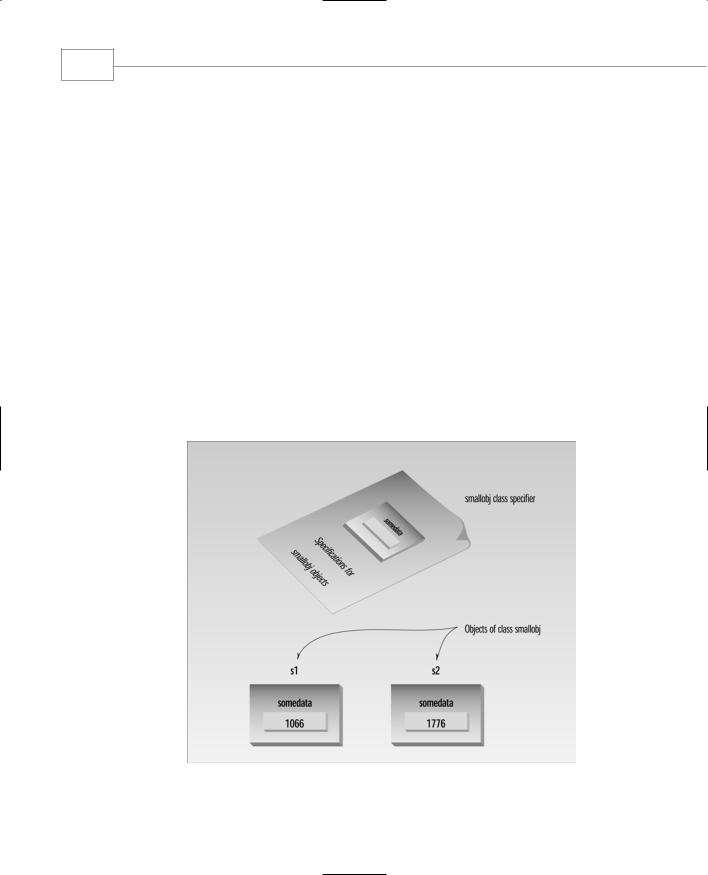
Chapter 6
222
by itself, because a member function is always called to act on a specific object, not on the class in general. Attempting to access the class this way would be like trying to drive the blueprint of a car. Not only does this statement not make sense, but the compiler will issue an error message if you attempt it. Member functions of a class can be accessed only by an object of that class.
To use a member function, the dot operator (the period) connects the object name and the member function. The syntax is similar to the way we refer to structure members, but the parentheses signal that we’re executing a member function rather than referring to a data item. (The dot operator is also called the class member access operator.)
The first call to setdata()
s1.setdata(1066);
executes the setdata() member function of the s1 object. This function sets the variable somedata in object s1 to the value 1066. The second call
s2.setdata(1776);
causes the variable somedata in s2 to be set to 1776. Now we have two objects whose somedata variables have different values, as shown in Figure 6.4.
FIGURE 6.4
Two objects of class smallobj.
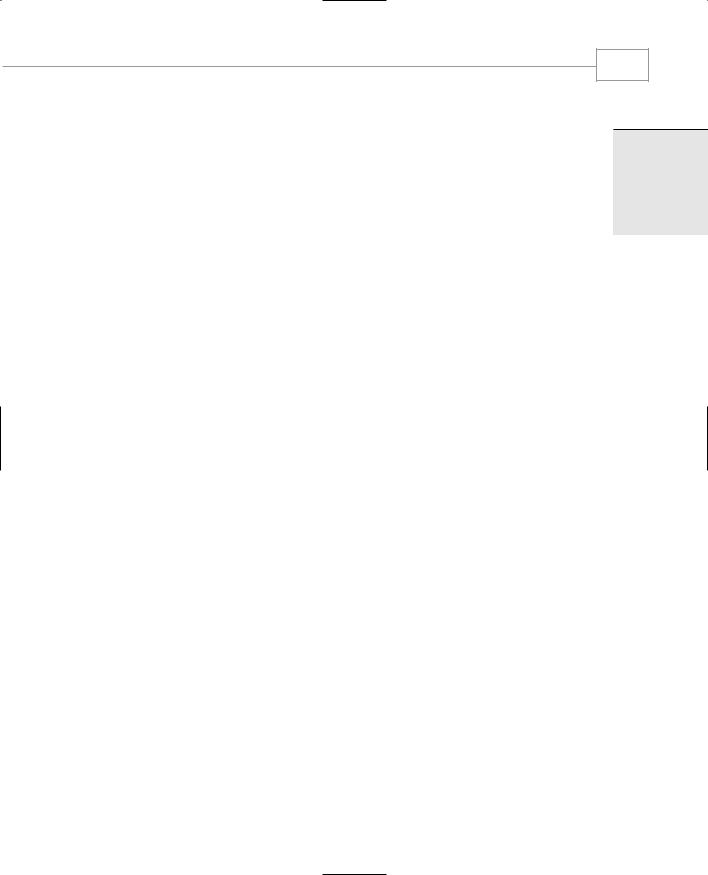
Objects and Classes
Similarly, the following two calls to the showdata() function will cause the two objects to display their values:
s1.showdata();
s2.showdata();
Messages
Some object-oriented languages refer to calls to member functions as messages. Thus the call
s1.showdata();
can be thought of as sending a message to s1 telling it to show its data. The term message is not a formal term in C++, but it is a useful idea to keep in mind as we discuss member functions. Talking about messages emphasizes that objects are discrete entities and that we communicate with them by calling their member functions. Referring to the analogy with company organization in Chapter 1, it’s like sending a message to the secretary in the sales department asking for a list of products sold in the southwest distribution area.
C++ Objects as Physical Objects
In many programming situations, objects in programs represent physical objects: things that can be felt or seen. These situations provide vivid examples of the correspondence between the program and the real world. We’ll look at two such situations: widget parts and graphics circles.
Widget Parts as Objects
The smallobj class in the last example had only one data item. Let’s look at an example of a somewhat more ambitious class. (These are not the same ambitious classes discussed in political science courses.) We’ll create a class based on the structure for the widget parts inventory, last seen in such examples as PARTS in Chapter 4, “Structures.” Here’s the listing for OBJPART:
//objpart.cpp
//widget part as an object #include <iostream>
using namespace std;
////////////////////////////////////////////////////////////////
class part |
//define class |
|
{ |
|
|
private: |
|
|
int modelnumber; |
//ID number of |
widget |
int partnumber; |
//ID number of |
widget part |
float cost; |
//cost of part |
|
public: |
|
|
void |
setpart(int mn, int pn, float c) //set data |
{ |
|
223
6
C OBJECTS
ANDLASSES

224 |
Chapter 6 |
|
modelnumber = mn; |
|
partnumber = pn; |
|
cost = c; |
|
} |
|
void showpart() |
//display data |
{ |
|
cout << “Model “ |
<< modelnumber; |
cout << “, part “ |
<< partnumber; |
cout << “, costs $” << cost << endl; |
|
} |
|
}; |
|
//////////////////////////////////////////////////////////////// |
|
int main() |
|
{ |
|
part part1; |
//define object |
|
// of class part |
part1.setpart(6244, 373, 217.55F); //call member function |
|
part1.showpart(); |
//call member function |
return 0; |
|
} |
|
This program features the class part. Instead of one data item, as SMALLOBJ had, this class has three: modelnumber, partnumber, and cost. A single member function, setpart(), supplies values to all three data items at once. Another function, showpart(), displays the values stored in all three items.
In this example only one object of type part is created: part1. The member function setpart() sets the three data items in this part to the values 6244, 373, and 217.55. The member function showpart() then displays these values. Here’s the output:
Model 6244, part 373, costs $217.55
This is a somewhat more realistic example than SMALLOBJ. If you were designing an inventory program you might actually want to create a class something like part. It’s an example of a C++ object representing a physical object in the real world—a widget part.
Circles as Objects
In our next example we’ll examine an object used to represent a circle: the kind of circle displayed on your computer screen. An image isn’t quite as tangible an object as a widget part, which you can presumably hold in your hand, but you can certainly see such a circle when your program runs.
Our example is an object-oriented version of the CIRCSTRC program from Chapter 5. (As in that program, you’ll need to add the appropriate Console Graphics Lite files to your project. These
